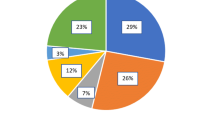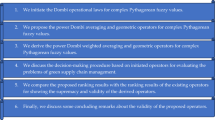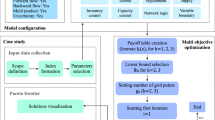Abstract
Sales and operations are the heart of today’s businesses, and the decisions made in these areas will intensively affect the financial performance, operational efficiency and service level of the whole organization. This manuscript is going to develop three multiobjective fuzzy mixed integer linear programming models of sales and operations planning process. Then, the performance of the fully integrated fuzzy model is compared to the similar crisp model, in terms of total supply chain’s cost and customer service level. All the models are developed for a multisite manufacturing company, which is coping with different raw material suppliers and third-party logistics, distribution centers and customers with a wide range of product families. Finally, the models are applied to a real case in a FMCG manufacturing company in Iran. The final results approve the superiority of the fuzzy model over the crisp one. Furthermore, a sensitivity analysis is carried out to analyze the effect of some key factors on the benefits of the SC planning integration.

















Similar content being viewed by others
References
Alavidoost MH (2017) Assembly line balancing problems in uncertain environment: a novel interactive fuzzy approach for solving multi-objective fuzzy assembly line balancing problems. LAP LAMBERT Academic Publishing, Riga, Latvia
Alavidoost M, Tarimoradi M, Zarandi M (2015a) Bi-objective mixed-integer nonlinear programming for multi-commodity tri-echelon supply chain networks. J Intell Manuf 29(4):809–826
Alavidoost M, Tarimoradi M, Zarandi MF (2015b) Fuzzy adaptive genetic algorithm for multi-objective assembly line balancing problems. Appl Soft Comput 34:655–677
Alavidoost M, Babazadeh H, Sayyari S (2016) An interactive fuzzy programming approach for bi-objective straight and U-shaped assembly line balancing problem. Appl Soft Comput 40:221–235
Alavidoost M, Zarandi MF, Tarimoradi M, Nemati Y (2017) Modified genetic algorithm for simple straight and U-shaped assembly line balancing with fuzzy processing times. J Intell Manuf 28(2):313–336
Baumann P, Trautmann N (2014) A hybrid method for large-scale short-term scheduling of make-and-pack production processes. Eur J Oper Res 236(2):718–735
Bellman RE, Zadeh LA (1970) Decision-making in a fuzzy environment. Manag Sci 17(4):B-141–B-164
Bilgen B, Çelebi Y (2013) Integrated production scheduling and distribution planning in dairy supply chain by hybrid modelling. Ann Oper Res 211(1):55–82
Bilgen B, Dogan K (2015) Multistage production planning in the dairy industry: a mixed-integer programming approach. Ind Eng Chem Res 54(46):11709–11719
Cecere L, Hillman M, Masson C (2006). The handbook of sales and operations planning technologies. In: AMR research report, AMRR-19187. pp 1–48
Chandra P, Fisher ML (1994) Coordination of production and distribution planning. Eur J Oper Res 72(3):503–517
Clark AJ, Scarf H (1960) Optimal policies for a multi-echelon inventory problem. Manag Sci 6(4):475–490
Dhaenens-Flipo C (2000) Spatial decomposition for a multi-facility production and distribution problem. Int J Prod Econ 64(1):177–186
El-Wahed WFA, Lee SM (2006) Interactive fuzzy goal programming for multi-objective transportation problems. Omega 34(2):158–166
Feng Y, Martel A, D’Amours S, Beauregard R (2013) Coordinated contract decisions in a make-to-order manufacturing supply chain: a stochastic programming approach. Prod Oper Manag 22(3):642–660. https://doi.org/10.1111/j.1937-5956.2012.01385.x
Fleischmann B, Meyr H, Wagner M (2015) Advanced planning supply chain management and advanced planning. Springer, Berlin, pp 71–95
Fumero F, Vercellis C (1999) Synchronized development of production, inventory, and distribution schedules. Transp Sci 33(3):330–340
Guan Z, Philpott AB (2011) A multistage stochastic programming model for the New Zealand dairy industry. Int J Prod Econ 134(2):289–299
Kır S, Yazgan HR (2016) A sequence dependent single machine scheduling problem with fuzzy axiomatic design for the penalty costs. Comput Ind Eng 92:95–104
Kopanos GM, Puigjaner L, Georgiadis MC (2011) Resource-constrained production planning in semicontinuous food industries. Comput Chem Eng 35(12):2929–2944
Kopanos GM, Puigjaner L, Georgiadis MC (2012a) Efficient mathematical frameworks for detailed production scheduling in food processing industries. Comput Chem Eng 42:206–216
Kopanos GM, Puigjaner L, Georgiadis MC (2012b) Simultaneous production and logistics operations planning in semicontinuous food industries. Omega 40(5):634–650
Lai Y-J, Hwang C-L (1992) A new approach to some possibilistic linear programming problems. Fuzzy Sets Syst 49(2):121–133
Ling R (2002) The future of sales and operations planning. In: Paper presented at the international conference proceedings of 2002 APICS
Nemati Y, Madhoshi M, Ghadikolaei AS (2017) The effect of sales and operations planning (S&OP) on supply chain’s total performance: a case study in an Iranian dairy company. Comput Chem Eng 104(Supplement C):323–338. https://doi.org/10.1016/j.compchemeng.2017.05.002
Nemati Y, Madhoushi M, Safaei Ghadikolaei A (2017) Towards supply chain planning integration: uncertainty analysis using fuzzy mathematical programming approach in a plastic forming company. Iran J Manag Stud 10(2):335–364
Olhager J, Rudberg M, Wikner J (2001) Long-term capacity management: linking the perspectives from manufacturing strategy and sales and operations planning. Int J Prod Econ 69(2):215–225
Pant R, Prakash G, Farooquie JA (2015) A framework for traceability and transparency in the dairy supply chain networks. Procedia Soc Behav Sci 189:385–394
Pauls-Worm KG, Hendrix EM, Haijema R, van der Vorst JG (2014) An MILP approximation for ordering perishable products with non-stationary demand and service level constraints. Int J Prod Econ 157:133–146
Sel Ç, Bilgen B (2015) Quantitative models for supply chain management within dairy industry: a review and discussion. Eur J Ind Eng 9(5):561–594
Sel C, Bilgen B, Bloemhof-Ruwaard J, van der Vorst J (2015) Multi-bucket optimization for integrated planning and scheduling in the perishable dairy supply chain. Comput Chem Eng 77:59–73
Shermeh HE, Najafi S, Alavidoost M (2016) A novel fuzzy network SBM model for data envelopment analysis: a case study in Iran regional power companies. Energy 112:686–697
Tarimoradi M, Alavidoost M, Zarandi MF (2015) Comparative corrigendum note on papers “Fuzzy adaptive GA for multi-objective assembly line balancing” continued “Modified GA for different types of assembly line balancing with fuzzy processing times”: differences and similarities. Appl Soft Comput 35:786–788
Touil A, Echchatbi A, Charkaoui A (2016) An MILP model for scheduling multistage, multiproducts milk processing. IFAC-PapersOnLine 49(12):869–874
Wahlers JL, Cox JF III (1994) Competitive factors and performance measurement: applying the theory of constraints to meet customer needs. Int J Prod Econ 37(2):229–240
Wallace TF (2004) Sales & operations planning: the “how-to” handbook. T.F. Wallace & Company, Cincinnati
Wari E, Zhu W (2016) Multi-week MILP scheduling for an ice cream processing facility. Comput Chem Eng 94:141–156
Williams JF (1983) A hybrid algorithm for simultaneous scheduling of production and distribution in multi-echelon structures. Manage Sci 29(1):77–92
Youssef MA, Mahmoud MM (1996) An iterative procedure for solving the uncapacitated production-distribution problem under concave cost function. Int J Oper Prod Manag 16(3):18–27
Zarandi MF, Tarimoradi M, Alavidoost M, Shakeri B (2015a) Fuzzy approximate reasoning toward multi-objective optimization policy: deployment for supply chain programming. In: Paper presented at the Fuzzy information processing society (NAFIPS) held jointly with 2015 5th world conference on soft computing (WConSC), 2015 annual conference of the North American
Zarandi MF, Tarimoradi M, Alavidoost M, Shirazi M (2015b) Fuzzy comparison dashboard for multi-objective evolutionary applications: an implementation in supply chain planning. In: Paper presented at the Fuzzy information processing society (NAFIPS) held jointly with 2015 5th world conference on Soft computing (WConSC), 2015 annual conference of the North American
Zimmermann H-J (1978) Fuzzy programming and linear programming with several objective functions. Fuzzy Sets Syst 1(1):45–55
Funding
This study was not funded by any profit or nonprofit organization.
Author information
Authors and Affiliations
Corresponding author
Ethics declarations
Conflict of interest
As authors of the manuscript, we, Yaser Nemati and Mohammad Hosein Alavidoost, declare that we have no conflict of interest to each other.
Ethical approval
This article does not contain any studies with human participants performed by any of the authors.
Informed consent
Informed consent was obtained from all individual participants included in the study.
Additional information
Communicated by V. Loia.
Rights and permissions
About this article
Cite this article
Nemati, Y., Alavidoost, M.H. A fuzzy bi-objective MILP approach to integrate sales, production, distribution and procurement planning in a FMCG supply chain. Soft Comput 23, 4871–4890 (2019). https://doi.org/10.1007/s00500-018-3146-5
Published:
Issue Date:
DOI: https://doi.org/10.1007/s00500-018-3146-5




